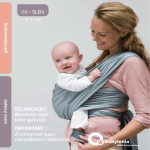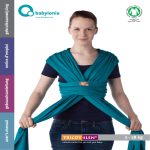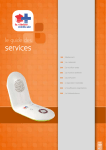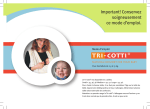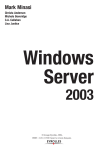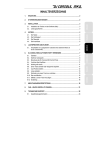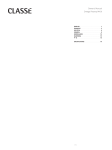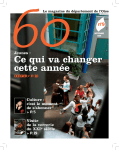Download Handleiding Mode d'emploi User guide - Boobs-'n
Transcript
Handleiding Mode d’emploi User guide De Lily-Balou draagdoeken zijn speciaal ontworpen voor actieve en trendy moeders. Eenvoudig en snel aan te doen en zo compact dat ze in je handtas of luiertas passen, zijn ze de meest praktische manier om je handen vrij en je kleine schat dicht bij je te houden. Les porte-bébé Lily-Balou ont spécialement été conçus pour les mères actives et à la mode. Faciles et rapides à enfiler et suffisamment compacts pour être emportés dans votre sac à main ou sac nursery, ils sont la manière la plus pratique pour avoir les mains libres et votre petit trésor tout contre vous. The Lily-Balou pouch slings have been specifically designed with active and trendy mothers in mind. They are easy and quick to slip on and compact meaning they easily fit in your handbag or diaper bag. They are in fact the most practical way of keeping your hands free and your baby close. De juiste maat. Om je baby op een comfortabele en veilige manier te kunnen dragen, is het zeer belangrijk dat je de juiste maat draagdoek kiest. De maat van de draagdoek is niet afhankelijk van de grootte van de baby, maar van de maat en lichaamsbouw van de drager. Om je maat te kiezen, meet je de afstand schouderheup en zoek je je maat op in de tabel hiernaast. Je hebt de juiste maat wanneer de onderkant van de buidel zich ter hoogte of net onder je navel bevindt. XS 52-56 cm La bonne taille. S 57-61 cm M 62-65 cm L 66-70 cm XL 71-75 cm Afin de pouvoir porter votre bébé confortablement et en tout sécurité, il est très important que vous choisissiez la bonne taille de porte-bébé. La taille du portebébé ne dépend pas de la grandeur du bébé mais de la taille et de la stature du porteur. Pour choisir votre taille, prenez la distance épaule-hanche et cherchez votre taille dans le tableau de gauche. Vous avez la bonne taille lorsque le côté inférieur de la poche se trouve, soit au niveau, soit juste sous le nombril (voir illustration). The right size. In order to carry around your baby comfortably and safely, it is very important that you choose the right size when buying a pouch sling. The size of the sling does not depend on your baby’s size, but on the size and build of the carrier. To choose your size, take your shoulder to hip measurement and look up your size in the table at the left. You have chosen the right size when the bottom of the pouch with your baby in it is situated at the height of or just below your navel (cfr picture). De draagdoek aandoen ◊ ◊ ◊ ◊ Vouw de draagdoek dubbel in de lengte zodat zich een buidel vormt Trek de draagdoek met de opening naar boven over je hoofd en één schouder zoals een burgemeesterslint. Zorg ervoor dat de stof gelijkmatig over je schouder verdeeld is en plat tegen je rug ligt Het diepste punt van de buidel moet zich ter hoogte van of iets onder je navel bevinden. De naad (met etiket) van de draagdoek is ofwel naar voren gedraaid, ofwel naar je heup (bij heupzit). Enfiler le porte-bébé ◊ ◊ ◊ ◊ Pliez le porte-bébé en deux dans le sens de la longueur afin d’obtenir une poche. Enfilez le porte-bébé au-dessus de votre tête avec l’ouverture vers le haut et sur une épaule comme une écharpe de bourgmestre. Assurez-vous que le tissu est réparti de façon égale sur votre épaule et est à plat sur votre dos. Le point le plus bas de la poche doit se trouver à la hauteur ou un rien en-dessous de votre nombril. La couture du porte-bébé (avec l’étiquette) est, soit dirigée vers l’avant, soit sur la hanche (lors du port sur la hanche). Slipping on your sling ◊ ◊ ◊ ◊ Fold your sling in two lengthwise so that a pouch is formed. Pull the pouch opening upwards over your head and over one shoulder like a sash. Ensure that the fabric is distributed evenly over your shoulder and is resting flat against your back The deepest point of the pouch has to be at the height of your navel or just below it. The seam of the pouch (with the label) is facing forwards or towards your hip (if the baby is sitting on your hip). Kommahouding (0-6 maanden) Deze houding is ideaal voor pasgeboren baby’s en geeft optimale ondersteuning van rug, nek en hoofdje. ◊ Leg je baby met zijn buikje tegen je schouder, alsof je hem een boertje wil doen laten. ◊ Open met je andere hand de buidel en plaats zijn voetjes tussen de twee lagen stof. ◊ Laat je baby in de buidel zakken terwijl je hem met zijn gezichtje naar boven draait. Plaats eerst zijn poepje op de naad en steek zijn voetjes in de buidel, open vervolgens de buidel wat verder zodat je ook zijn hoofdje tegen je aan kan laten rusten. ◊ Zorg ervoor dat de buidel langs beide zijden van de baby even hoog komt. OPGELET: zorg er altijd voor dat je baby vrij kan ademen en dat zijn kin niet tegen zijn borstkas gedrukt wordt. Indien dit zo is, plaats de baby dan iets hoger (verticaler) in de buidel. Position “berceau” (0-6 mois) Ceci est la position parfaite pour les nouveau-nés et soutient au maximum leur dos, cou et tête. ◊ Mettez votre bébé avec le ventre sur votre épaule comme si vous vouliez lui faire faire son rot. ◊ Avec votre autre main, ouvrez la poche et mettez ses pieds entre les deux couches de tissu. ◊ Descendez votre bébé dans la poche tout en tournant son visage vers le haut. ◊ Déposez d’abord ses petites fesses sur l’ourlet et mettez ses pieds dans la poche, ensuite ouvrez un peu plus la poche afin de faire reposer sa tête contre vous. ◊ Assurez-vous que la poche arrive à même hauteur des deux côtés et que le bébé puisse respirer facilement. ATTENTION: assurez-vous toujours que votre bébé peut respirer librement et que son menton ne soit pas coincé contre sa poitrine. Si c’est le cas, remontez le bébé (verticalement) dans la poche. Cradle hold (0-6 months) This position is perfect for newborn babies and gives optimum support to their neck, back and head. ◊ Place your baby with his belly against your shoulder as if you wish to let him or her burp. ◊ Open the pouch with your other hand and place your baby’s feet between the two layers of fabric. ◊ Gently slide your baby into the pouch while positioning him with his or her face facing up. First position your baby’s behind on the seam and then position his or her feet into the pouch, then open the pouch a little more so that your baby’s head can rest against your body. ◊ Ensure that the pouch is level on either side of your baby and that your baby can breathe easily. ATTENTION: Always ensure that your baby can breathe freely and that your baby’s chin is not pressed into his or her thorax. If this is the case, then position your baby a little higher (more vertically) in the pouch. Kangoeroehouding / Buik-tegen-buik (0-3 maanden) ◊ ◊ ◊ ◊ ◊ ◊ ◊ Leg je baby met zijn buikje tegen je schouder, alsof je hem een boertje wil doen laten. Open met je andere hand de buidel en plaats zijn voetjes tussen de twee lagen stof. Laat de baby in de buidel zakken, zijn beentjes geplooid als een kikkertje (natuurlijke houding voor een pasgeborene). Zorg dat zijn poepje tot op de bodem van de buidel zit en dat de bovenkant van de buidel het hoofdje goed ondersteunt. Trek, indien je baby nog geen hoofdcontrole heeft, de stof tot over de helft van zijn hoofdje, zodat dat goed ondersteund wordt. Het gezichtje dient naar links of rechts gedraaid te zijn zodat de baby makkelijk kan ademen. Je baby ligt nu in dezelfde natuurlijke houding als wanneer je hem al liggend op je borst legt. Position kangourou / Ventre-contre-ventre (0-3 mois) ◊ ◊ ◊ ◊ ◊ ◊ ◊ Mettez votre bébé avec le ventre sur votre épaule comme si vous vouliez lui faire faire son rot. Avec votre autre main, ouvrez la poche et mettez ces pieds entre les deux couches de tissu. Descendez le bébé dans la poche, ses jambes repliées comme une grenouille (position naturelle pour un nouveau-né). Veillez à ce que ses fesses soient bien au fond de la poche et que la partie supérieure de la poche soutienne bien sa tête. Si votre bébé n’a pas encore le contrôle de sa tête, tirez le tissu jusqu’à la moitié de sa tête pour lui assurer un bon soutien. Le visage doit être tourné à gauche ou à droite afin de faciliter la respiration du bébé. Votre bébé a ainsi la même position naturelle que lorsque vous le couchez sur votre poitrine. Kangaroo position / Belly to belly (0-3 months) ◊ ◊ ◊ ◊ ◊ ◊ ◊ Place your baby with his belly against your shoulder as if you wish to let him or her burp. Open the pouch with your other hand and place your baby’s feet between the two layers of fabric. Gently slide the baby into the pouch, his or her legs folded like a frog (the natural position for a newborn). Make sure that your baby’s behind is sitting on the bottom of the pouch and that the fabric provides sufficient support for your baby’s head. If your baby is not yet capable of supporting its head, then pull the fabric up halfway past his or her head, so that it is properly supported. Your baby’s face has to be turned left or right, so that your baby can breathe freely. Your baby is now positioned in the same natural position as when you place him on your chest as he sleeps. Buik-tegen-buik (vanaf 3 maanden) ◊ ◊ ◊ ◊ ◊ ◊ Een grotere baby kan in dezelfde positie gedragen worden, maar dan met zijn beentjes uit de buidel. Leg je baby met zijn buikje tegen je schouder, alsof je hem een boertje wil doen laten. Trek met je andere hand de buitenkant van de buidel omhoog zodat die hoger komt dan de binnenkant. Laat de baby zakken maar zorg dat zijn voetjes niet in de buidel blijven steken. Trek, terwijl je lichtjes voorover leunt, de onderste rand van de buidel onder baby’s poepje zodat het diep in de buidel zit met de knietjes hoger en de beentjes rond je lichaam gespreid. Trek de bovenste rand tot bovenaan zijn rugje. Ventre-contre-ventre (à partir de 3 mois) ◊ ◊ ◊ ◊ ◊ ◊ Un bébé plus grand peut être porté dans la même position mais avec ses jambes hors de la poche. Mettez votre bébé avec le ventre sur votre épaule comme si vous vouliez lui faire faire son rot. Avec votre autre main, remontez le côté extérieur de la poche afin qu’il soit plus haut que le côté intérieur. Descendez le bébé mais veillez à ce que ses pieds ne soient pas dans la poche. En vous penchant légèrement en avant, tirez la partie inférieure de la poche sous les fesses du bébé afin de l’asseoir profondément dans la poche avec les genoux plus haut et ses jambes autour de votre corps. Remontez le bord supérieur jusqu’au haut de son dos. Belly to belly (from 3 months onwards) ◊ ◊ ◊ ◊ ◊ ◊ An older baby can be carried in the same position, but with his legs protruding from the pouch. Place your baby with his belly against your shoulder as if you wish to let him or her burp. Use your other hand to pull the outside of the pouch up so that it is higher than the inside of the pouch. Gently slide your baby between the pouch and your body ensuring that his feet do not get stuck in the pouch. Pull the bottom of the pouch under his buttocks up behind his knees as you bend over slightly. Ensure that your baby is positioned deep enough and that his knees are higher than his behind so that his legs are not supporting his weight. Pull the top part of the fabric all the way up your baby’s back. Bouddhahouding (4-10 maanden) ◊ ◊ ◊ ◊ ◊ ◊ Deze houding is ideaal voor iets oudere baby’s die graag iets van de wereld zien. Hou je kindje tegen je schouder met zijn gezichtje naar voren gericht. Kruis zijn beentjes voor hem, en hou ze met één hand gekruist. Open met de andere hand de buidel en laat je baby zakken tot in het diepste deel. Zorg dat de buitenkant van de buidel tot aan zijn borst komt, de armpjes kunnen in of uit de buidel zitten. De baby moet tegen je lichaam aanleunen, indien hij teveel naar voor leunt, haal hem er dan uit en plaats hem zo dat hij meer naar achteren leunt. Position de Bouddha (4-10 mois) ◊ ◊ ◊ ◊ ◊ ◊ Ceci est la position idéale pour de plus grands bébés qui aiment voir le monde. Tenez votre enfant à hauteur d’épaule, le visage tourné vers l’avant. Croisez ses jambes devant lui et gardez-les ainsi avec une main. De l’autre main, ouvrez la poche et faites descendre votre bébé jusqu’à la partie la plus profonde. Veillez à ce que la partie extérieure de la poche arrive jusqu’à sa poitrine, les bras peuvent être dans ou en dehors de la poche. Le bébé doit s’appuyer contre votre corps, s’il pend trop vers l’avant, sortez-le et replacez-le de telle façon qu’il s’appuie plus vers l’arrière. Buddha hold (4-10 months) ◊ ◊ ◊ ◊ ◊ ◊ This position is ideal for somewhat older babies who like to keep an eye on what’s going on. Hold your baby against your shoulder with his face facing away from you. Cross his or her legs in front of him or her, and keep them crossed using your hand. Open the pouch with your other hand and gently slide your baby into the deepest part of the pouch. Make sure that the outside of the pouch covers your baby’s chest; the arms can be kept inside or outside of the pouch. Your baby has to lean into you, if your baby leans forward too much, then take him or her out of the pouch and reposition your baby until he or she leans back more. Heupzit (vanaf 5 maanden) ◊ ◊ ◊ ◊ ◊ Draai de zoom van de buidel boven je heup en trek de buitenkant hoger dan de binnenkant. Leg je baby met zijn buikje tegen je schouder. Plaats met je andere hand zijn beentjes tussen je lichaam en de draagdoek en laat hem in de buidel zakken. De zoom moet over het midden van zijn rugje lopen. Trek de onderkant van de buidel onder zijn billetjes tot in zijn knieholtes terwijl je lichtjes voorover buigt. Zorg dat hij diep genoeg zit en dat zijn knietjes hoger hangen dan zijn billetjes, zodat zijn gewicht niet op zijn beentjes rust. Trek de bovenkant van de buidel op tot bovenaan zijn rugje. Sur la hanche (à partir de 5 mois) ◊ ◊ ◊ ◊ ◊ Mettez la couture de la poche au-dessus de votre hanche et tirez le côté extérieur plus haut que le côté intérieur. Mettez votre bébé avec le ventre contre votre épaule. Avec votre autre main, mettez ses jambes entre votre corps et le porte-bébé et descendez-le dans la poche. La couture doit être au milieu de son dos. En vous penchant légèrement en avant, tirez la partie inférieure de la poche sous ses fesses jusqu’au creux de ses genoux. Veillez à ce qu’il soit assis suffisamment bas et que ses genoux soient plus haut que ses fesses afin que son poids ne repose pas sur ses jambes. Tirez la partie supérieure de la poche jusqu’au haut de son dos. Hip hold (From 5 months onwards) ◊ ◊ ◊ ◊ ◊ Turn the seam of the pouch above your hip and make sure that the outside of the fabric is higher than the inside. Position your baby with his belly against your shoulder. Gently slide your baby between the pouch and your body ensuring that his feet do not get stuck in the pouch. The seam has to run across the middle of your baby’s back. Pull the bottom of the pouch under his buttocks up behind his knees as you bend over slightly. Ensure that your baby is positioned deep enough and that his knees are higher than his behind so that his legs are not supporting his weight. Pull the top of the fabric all the way up your baby’s back. Tips 1. 2. de draagdoek strakker maken ◊ Om je baby iets dichter tegen je aan te trekken in de buik-tegen-buik positie of in heupzit, kan je de bovenste laag stof om over je schouder plooien zodat de binnenkant van de draagdoek zichtbaar wordt. wat als mijn baby de draagdoek niet leuk vindt? ◊ BEWEEG met je baby in de draagdoek. Loop, kuis, praat, streel, huppel, dans, zing… Rythmische bewegingen zijn rustgevend en zullen je baby afleiden. ◊ Laat je baby enkele minuutjes wennen aan het nieuwe gevoel. Als hij niet echt over zijn toeren geraakt, haal hem er dan uit en probeer het later nog eens opnieuw. Hoe jonger je start, hoe beter, maar elke baby kan eraan wennen om in een draagdoek gedragen te worden, sommigen hebben gewoon wat meer tijd nodig. ◊ Ontspan je. Je baby voelt het aan als je gespannen bent. Als het niet onmiddellijk lukt, adem dan eens diep en ontspan je, of probeer het later nog eens opnieuw. ◊ Gebruik de draagdoek niet voor het eerst als je baby hongerig of moe is. ◊ Probeer eens een andere houding. Sommige pasgeboren baby’s verkiezen de iets meer verticale buiktegen-buik houding boven de komma houding. ◊ Kijk voor meer tips over het dragen en het geven van borstvoeding in de draagdoek op onze website www.lilbalou.be Conseils 1. 2. Serrer votre porte-bébé ◊ Pour rapprocher le bébé contre soi dans la position ventre-contre-ventre ou sur la hanche, on peut replier la partie supérieure du tissu sur l’épaule de telle façon que l’intérieur du tissu soit visible. Que faire si mon bébé ne se sent pas à l’aise dans le porte-bébé? ◊ BOUGEZ avec le bébé dans le porte-bébé. Courez, nettoyez, parlez, caressez, sautillez, dansez, chantez.... Les mouvements rythmés sont apaisants et distrairont votre bébé. ◊ Donnez le temps à votre bébé de s’adapter à la nouvelle sensation. S’il ne parvient pas à se calmer, sortez-le et essayez une autre fois. Au plus jeune vous commencez, au mieux cela vaut, mais tous les bébés peuvent s’habituer à être portés dans un porte-bébé, certains ont tout simplement besoin d’un peu plus de temps. ◊ Détendez-vous. Votre bébé sent lorsque vous êtes tendue. Si cela ne réussit pas du premier coup, inspirez un bon coup et détendez-vous, ou refaites un essayer plus tard. ◊ N’étrennez pas le porte-bébé lorsque votre bébé est affamé ou fatigué. ◊ Essayez une autre position. Certains nouveau-nés préfèrent la position légèrement plus verticale ventre-contre-ventre à la position berceau. ◊ Pour plus de conseils concernant le portage ou l’alaitement dans le porte-bébé, consultez notre site internet www.lilybalou.com Tips and tricks 1. 2. Tightening the pouch. ◊ You can pull your baby somewhat closer in the belly to belly or hip hold by using the shoulder “flip”. Fold the top layer of fabric around your shoulder so the inside of the pouch becomes visible. What if my baby doesn’t seem to like the pouch? ◊ MOVE with your baby in the pouch. Walk, clean, talk, caress, hop, dance or sing... Rhythmic movements have a soothing effect and will distract your baby. ◊ Give your baby a few minutes to get used to this new sensation. If he shows signs of distress, then take your baby out of the sling and try again later. The younger you start, the better, but each baby can get used to being carried in a pouch. Some babies just need more time. ◊ Relax. Your baby can feel that you are tense. If you do not immediately succeed, breathe deeply, relax and try again later. ◊ Do not use your sling for the first time when your baby is tired or hungry. ◊ Try another position. Some new-borns prefer the more vertical belly to belly hold to the cradle hold. ◊ For more carrying and breastfeeding tips, check our website www.lilybalou.com Veiligheid ◊ ◊ ◊ ◊ ◊ ◊ Gebruik altijd je gezond verstand wanneer je je baby draagt, uiteindelijk is hij je kostbaarste bezit! Hou je baby uit de buurt van kookplaten, ovens en andere warme of gevaarlijke voorwerpen. Denk eraan dat peuters in de draagdoek op een hoogte zitten waarop ze alles kunnen grijpen, en dat ook fantastisch vinden! Hou ze weg van gevaarlijke voorwerpen en hou altijd in het oog waarmee ze bezig zijn. Denk eraan dat je baby niet vastzit in de draagdoek: buig door je knieën, en niet voorover, en hou je baby met één hand tegen. Gebruik de draagdoek niet op de fiets! Controleer regelmatig je draagdoek op sporen van sleet of schade. Sécurité ◊ ◊ ◊ ◊ ◊ ◊ Employez toujours votre bon sens lorsque vous portez votre bébé, c’est finalement votre bien le plus précieux! Eloignez votre bébé de plaques de cuisson, fours et autres objets chauds ou dangereux. Rappelez-vous que les bambins dans le porte-bébé sont assis à une hauteur où ils peuvent tout atteindre, ce qu’ils adorent! Eloignez-vous des objets dangereux et tenez-les toujours à l’oeil. Pensez que votre bébé n’est pas attaché dans le porte-bébé: pliez les genoux et ne vous penchez pas en avant, et retenez votre bébé avec une main. N’utilisez pas le porte-bébé si vous roulez à vélo! Contrôlez régulièrement votre porte-bébé pour voir s’il présente des traces d’usure ou d’endommagement. Safety ◊ ◊ ◊ ◊ ◊ ◊ ◊ Always use your common sense, when carrying your baby. At the end of the day, he or she is your most precious treasure. Keep your baby away from hobs, ovens and other warm or dangerous objects. Remember that toddlers in a pouch find themselves at a height where they can grab everything and they love it! Keep them away from dangerous objects and always keep an eye on what they are doing. Remember: your baby is not fastened in the pouch: Bend through your knees and do not bend over, and brace your baby with one hand. Do not use the pouch on the bicycle! Regularly check your pouch for traces of wear and tear. www.lilybalou.be












